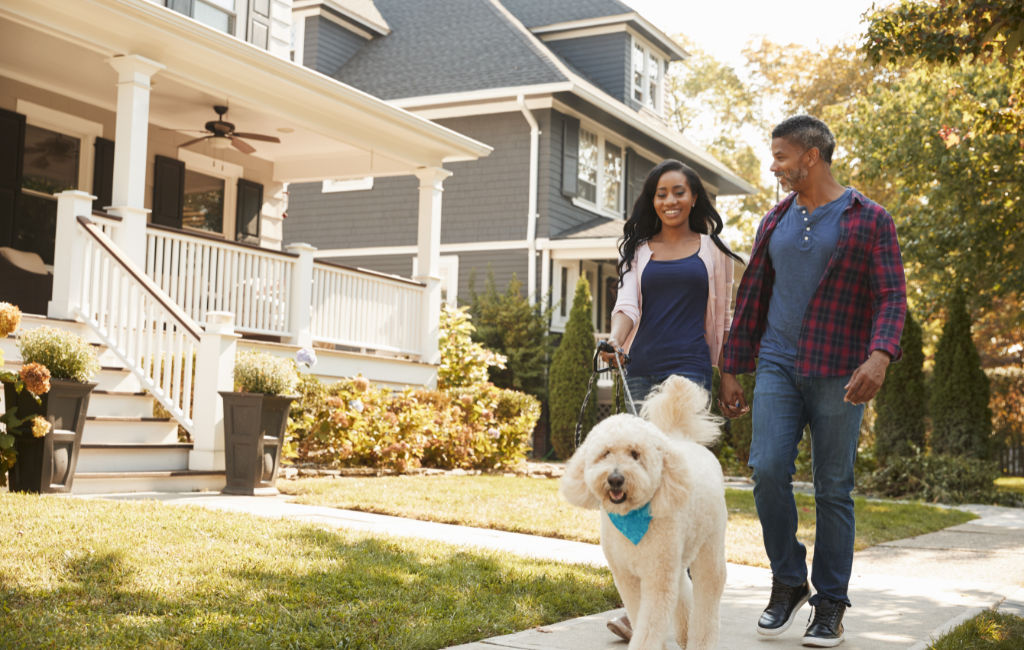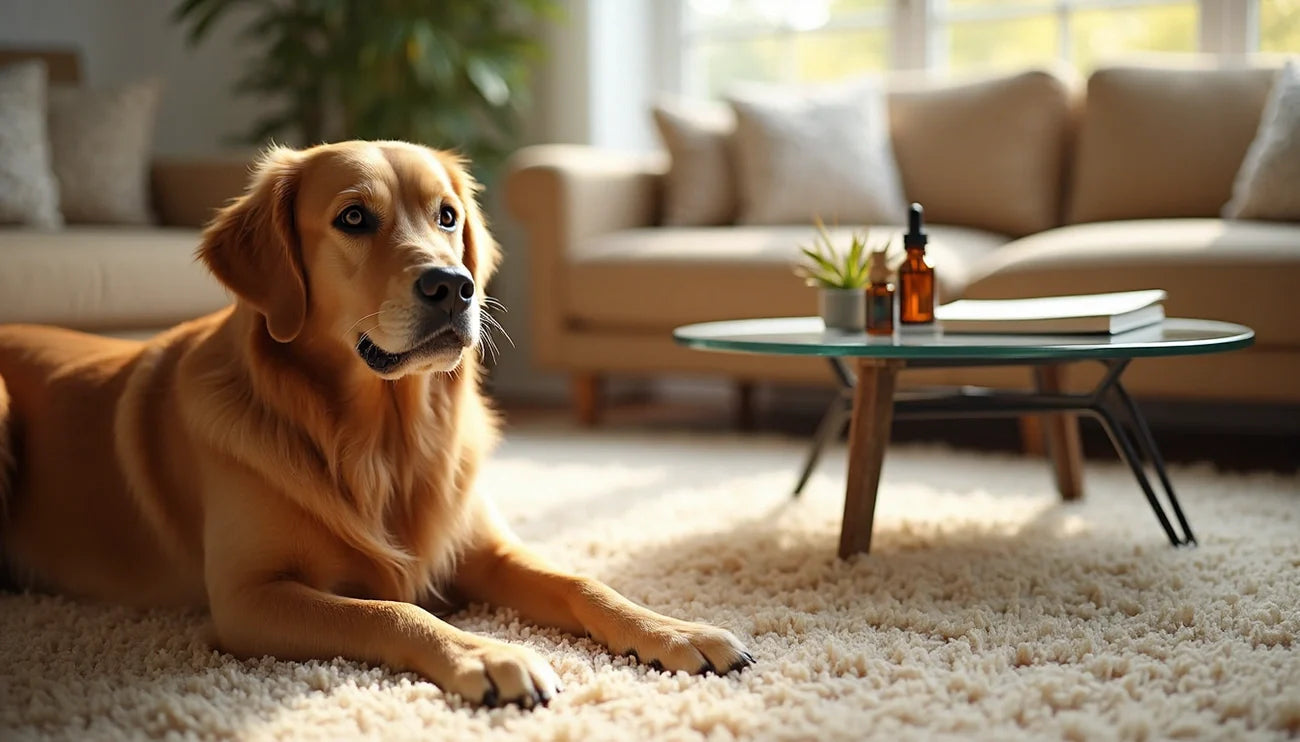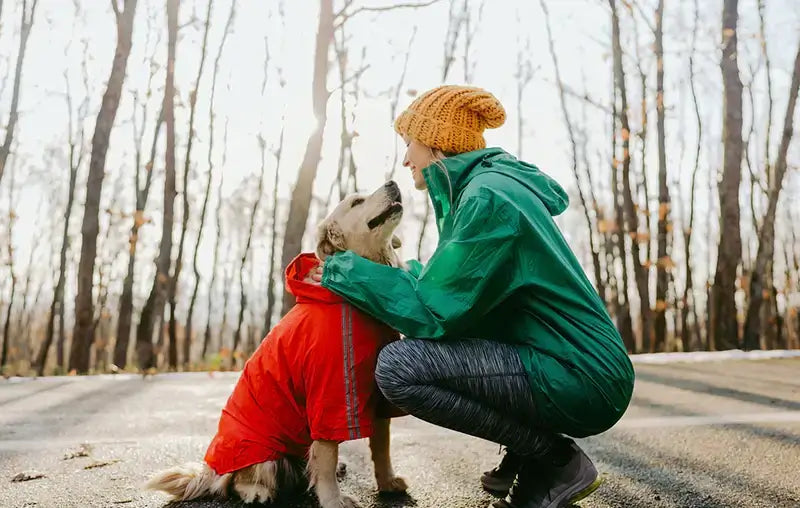
If your dog needs calming on occasion, you’re not alone. A 2020 study published by Scientific Reports found that 72.5% of the 13,715 dogs (representing 264 breeds) that took part in the study showed at least one occasional stress-related behavior.
The most common stress-inducing issue was noise sensitivity, which was found to affect almost one-third of the dogs in the study. (See our blog on how to calm a dog during a thunderstorm). At 29%, occasional fear (of other dogs, of strangers, or of novel situations) was the second most common trait. Clocking in at number three at 23.5% was fear of different surfaces and heights, which was placed in a separate category. So what causes your dog to need calming down? Part of the answer is genetics. There are breeds of dogs that are more excitable than others, including the Border Collie, Labradoodle, Siberian Husky, Australian Shepherd and Jack Russell Terrier.
The more exercise your dog gets, the less likely he is to exhibit destructive behavior, and his stress and fear levels will tend to be lower.
On the flip side are the calmer breeds, which include the Cavalier King Charles Spaniel, Boerboel, Bergamasco Sheepdog and Basset Hound.
How to Calm Down a Hyper Dog
But there’s more to it than genetics. Other factors that can influence your dog’s temperament include whether they were abandoned or treated poorly by a previous owner; their age and their lifestyle. Plus, while the dogs on the hyperactive list are known to be less calm, any dog can become hyper at any given time, which can result in your dog pacing about, trembling, whimpering, panting, fidgeting, barking, drooling, hiding in a confined space, chewing the carpet or other parts of your home, urinating, defecating or vomiting … the list goes on. When one or more of those behaviors becomes unmanageable, it can result in an owner giving up on their beloved pet.
To make sure that doesn’t happen, here are 12 ways to calm down a hyperactive dog:
- Establish a routine. Dogs are routine-oriented animals. They love to know what to expect and when to expect it. Any disruption of their routine may cause them stress. Feed your dog at the same time every day, preferably around the same time you eat. Ideally, dogs should be taken outside to relieve themselves every four hours. Dogs need more sleep than humans. Establish a bedtime routine with your dog, such as giving him a treat just before bedtime, so he looks forward to it.
- Exercise your dog. When it comes to hyperactivity, exercise is not only an effective way to get your dog to calm down, it also keeps him healthy and happy. Physical activity triggers the release of chemicals called endorphins in both dogs and humans that relieve stress and discomfort. While some dogs need more exercise than others, it’s recommended that dogs get 30 minutes to two hours of exercise each day. Take your dog out for a brisk walk several times a day. Teach him how to catch a Frisbee. Go for a swim with him. Take him to the dog park. Physical exercise is good for both your dog’s physical and mental well-being. The more exercise your dog gets, the less likely he is to exhibit destructive behavior, and his stress and fear levels will tend to be lower. If you do not have the time to exercise with your dog, there is also the option of hiring a dog walker. When your pup is not exercising, make sure your dog has a chew toy or bully stick to help with hyperactive behavior.
- Emphasize physical contact. Dogs naturally love touch. Picking them up, cuddling with them on the couch, petting them and giving them a gentle massage are ways how to get a dog to calm down and to show your dog you love him. When your dog feels the love from you, his level of oxytocin (also known as “the love hormone”) goes up.
- Be mindful of your dog’s diet. A healthy diet is essential to your dog’s wellbeing. Not only do obese dogs find it more difficult to work off excess energy, but they also are more susceptible to disease and premature death. Plus, they will sleep better, and a rested dog is more likely to be a calm dog.
- Employ music therapy. The right type of music can be soothing for both humans and dogs. It will block out external noise (street sounds, thunderstorms, etc.) that could upset your dog. YouTube has plenty of music designed to show you how to calm an overexcited dog, as do streaming services such as Spotify, Deezer, Tidal and Apple music.
- Use essential oils. A dog’s nose contains 100 million olfactory receptors (compared with about six million in the human nose). It’s estimated that dogs can smell anywhere from 1,000 to 100,000 times better than people. Calming essential oils such as bergamot, lavender, sweet marjoram and rose damask can balance out your dog’s mood and keep him calm. Try adding these scents to an aromatherapy diffuser to create a calming aura for your dog.
- Look into synthetic dog pheromones. These chemical signals are emitted by many animals and are noticed by other animals, including dogs. (It’s unknown whether humans produce or react to pheromones.) Dogs release different pheromones based on the circumstances. Synthetic versions of dog pheromones have proven effective in getting a dog to calm down in occasional stress-inducing situations.
- Emphasize socialization. Continually introduce your dog to new dogs, people, animals, places and experiences. Variety in life can help them avoid behavior problems down the road. It’s best to start socialization when your dog is between eight weeks and four months old, but it’s never too late. Also, always be sure to keep your dog or puppy on a leash no matter how well-behaved he is.
- Explore behavior modification training. Practice positive dog training if you have a high-energy dog. As the name implies, the goal of behavior modification is to promote normal, wanted behavior. There are two main types of behavior modification: Classical conditioning and operant conditioning. In classical conditioning behavior is learned by association. It’s based on Pavlov's dog method, wherein a dog is trained to associate the ringing of a bell with the presentation of food. Eventually, when a bell is rung, the dog’s fear will be replaced with the anticipation of receiving a treat. “Operant conditioning,” employs rewards and punishments —. for example, giving a dog a treat when he stops barking, but delaying the treat if he ignores your command to stop.
- Shop for anti-stress clothing. There are various clothing-related devices designed to have a calming effect on your dog, such as an anti-stress jacket, calming caps and basket muzzles.
- Try canine CBD products. Like humans, dogs also have an endocannabinoid system (ECS). The ECS acts on multiple systems in your dog’s body, including the cardiovascular, respiratory, reproductive and nervous systems. The ECS sends out neurotransmitters to all your dog’s body parts to check whether everything is running smoothly. If it finds a problem, it sends out instructions on how to fix it. However, the ECS is easy to throw out of whack. Diet, exercise, stress level and so on can take a toll on it. When that happens, dog CBD can provide a range of potential health benefits. The compounds found in the cannabis plant – from which CBD is extracted — interact positively with his ECS, which is why CBD has gained the reputation of having a calming effect on both humans and dogs. This makes it the ideal natural solution to help keep your dog calm. At Zebra CBD, we offer CBD in two forms designed specifically to have a calming effect on your dog: our CBD Canine Stress & Calming Chews and our CBD Canine Oil for Dogs.
If you’re at your wit’s end when it comes to how to calm your dog down, consult with your veterinarian, who can help identify the source of your dog’s agitation and how serious it is. Plus, your vet will put together a treatment plan for your dog.
At the same time, keep in mind that if you can’t figure out how to calm down a hyper dog, it’s not his fault. There are a lot of factors at work, so always try to be patient and supportive when it comes to your dog’s behavioral quirks. After all, he will reward you with unconditional love.










